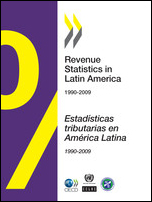Development Centre
Revenue Statistics in Latin America
|
|
Revenue Statistics in Latin America is a joint publication by the Organisation for Economic Co-operation and Development (OECD) Centre for Tax Policy and Administration, the OECD Development Centre, the Economic Commission for Latin America and the Caribbean (ECLAC) and the Inter-American Centre of Tax Administrations (CIAT).
Its aim is to provide internationally comparable data on tax levels and tax structures for a selection of Latin American and Caribbean (LAC) countries. The model is the OECD Revenue Statistics database which is a fundamental reference, backed by a well-established methodology, for OECD member countries. By extending this OECD |
methodology to LAC Revenue Statistics in Latin America enables meaningful cross-country comparisons about tax levels and structures not only between LAC economies, but also between them and their industrialised peers.
The report provides an overview of the main taxation trends in Latin America. It examines changes in both the level and the composition of taxation plus the attribution of tax collection by sub-level of government between 1990 and 2009.
- Download the flyer here. (disponible tambien en español)
- Read the press release here: Rising tax revenues: A key to economic development in Latin American countries (disponible tambien en español).
- Visit the page on Latameconomy.org or www.oecd.org/tax/lacfiscal for more information.
Table of Contents
Foreword
Acknowledgments
Part I. Tax Revenue Trends 1990-2009
A. Tax ratios
B. Tax structures
C. Taxes by level of government
D. The impact of natural resources on reported tax levels
E. Comparative charts
References
Part II. Tax Levels and Tax Structures, 1990-2009
A. Comparative Tables, 1990-2009
B. Comparative charts
Part III. Country Tables, 1990-2009 – Tax revenues
Part IV. Tax Revenues by Sub-Sectors of General Government
Annex A
The OECD Classification of Taxes
The OECD Interpretative Guide
A. Coverage
B. Basis of reporting
C. General classification criteria
D. Commentaries on items of the list
E. Conciliation with National Accounts
F. Memorandum item on the financing of social security benefits
G. Memorandum item on identifiable taxes paid by government
H. Relation of OECD classification of taxes to national accounting systems
I. The OECD classification of taxes and the International Monetary Fund (GFS) system
J. Comparison of the OECD classification of taxes with other international classifications
K. Attribution of tax revenues by sub-sectors of general government
Selected tables
Part I. Tax Revenue Trends 1990-2009
Table A. Total tax revenue as percentage of GDP
Table B. Value added taxes as percentage of GDP
Table C. Tax structures in a selected group of Latin American countries
Table E. Characteristics of national tax regimes for non-renewables tax revenue in selected Latin American countries, 2008
Part II. Tax Levels and Tax Structures, 1990-2009
Table 1. Total tax revenue as percentage of GDP
Table 2-3. Tax revenue of main headings as percentage of GDP and total taxation
Table 4-5. Taxes on income and profits (1000) as percentage of GDP and total taxationTable 6-7. Social security contributions (2000) as percentage of GDP and total taxation
Table 8-9. Taxes on property (4000) as percentage of GDP and total taxation
Table 10-11. Taxes on goods and services (5000) as percentage of GDP and total taxation
Table 12-13. Taxes on general consumption (5110) as percentage of GDP and total taxation
Table 14-15. Taxes on specific goods and services (5120) as percentage of GDP and total taxation
Access
Readers can access the full version of Revenue Statistics in Latin America 1990-2009 Edition as follows:
Subscribers and readers at subscribing institutions can access the online edition via OECD iLibrary.
Non-subscribers can purchase the PDF e-book and/or paper copy via our Online Bookshop.
Government officials with accounts can go to the "Books" tab on OLIS.
Secure password access for accredited journalists.
For more information, please e-mail dev.contact@oecd.org and ctp.contact@oecd.org
Related Documents
